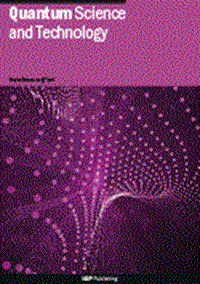量子网络中的渗透阈值和连通性
IF 5
2区 物理与天体物理
Q1 PHYSICS, MULTIDISCIPLINARY
引用次数: 0
摘要
我们研究了基于量子比特的平面任意拓扑量子网络模型中的纠缠渗透,其中相邻节点最初是由纯态连接的,它们的纠缠是淬火无序的。为了解决这个问题,我们开发了一种基于物理的启发式算法,旨在找到一系列纠缠交换和蒸馏操作,以连接任何对远程节点。该算法结合节点间的局部最优渗透策略,最大距离为一次交换操作。如果这不能产生最大的纠缠态,它就会在过程中寻找围绕中间态的替代路径。我们分析并数值验证了量子渗透中的阈值,这些阈值取决于初始网络配置和纠缠,并与特定的渗透策略相关。我们根据连通性对这些策略进行分类,连通性是一个与最终状态的纠缠和过程结束时网络的完整性水平相关的量。我们发现了不同的量子渗透机制,它们被所采用策略的渗透阈值清楚地分开,并且根据网络拓扑结构有很大的不同。本文章由计算机程序翻译,如有差异,请以英文原文为准。
Percolation thresholds and connectivity in quantum networks
We study entanglement percolation in qubit-based planar quantum network models of arbitrary topology, where neighboring nodes are initially connected by pure states with quenched disorder in their entanglement. To address this, we develop a physics-informed heuristic algorithm designed to find a sequence of entanglement swapping and distillation operations to connect any pair of distant nodes. The algorithm combines locally optimal percolation strategies between nodes at a maximum distance of one swapping operation. If this fails to produce a maximally entangled state, it looks for alternative paths surrounding intermediate states within the process. We analytically find and numerically verify thresholds in quantum percolation, which depend on the initial network configuration and entanglement, and are associated with specific percolation strategies. We classify these strategies based on the connectivity, a quantity that relates the entanglement in the final state and the level of integrity of the network at the end of the process. We find distinct regimes of quantum percolation, which are clearly separated by the percolation thresholds of the employed strategies and vastly vary according to the network topology.
求助全文
通过发布文献求助,成功后即可免费获取论文全文。
去求助
来源期刊

Quantum Science and Technology
Materials Science-Materials Science (miscellaneous)
CiteScore
11.20
自引率
3.00%
发文量
133
期刊介绍:
Driven by advances in technology and experimental capability, the last decade has seen the emergence of quantum technology: a new praxis for controlling the quantum world. It is now possible to engineer complex, multi-component systems that merge the once distinct fields of quantum optics and condensed matter physics.
Quantum Science and Technology is a new multidisciplinary, electronic-only journal, devoted to publishing research of the highest quality and impact covering theoretical and experimental advances in the fundamental science and application of all quantum-enabled technologies.
 求助内容:
求助内容: 应助结果提醒方式:
应助结果提醒方式:


